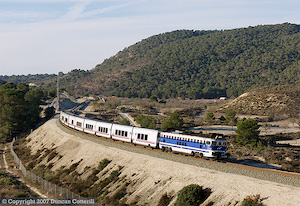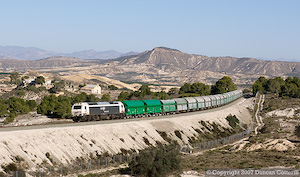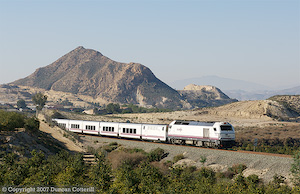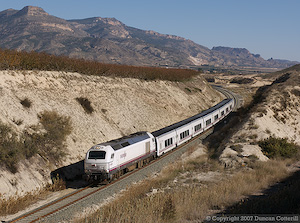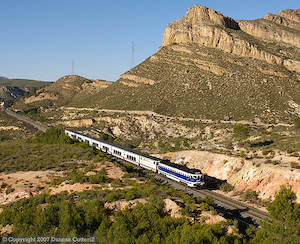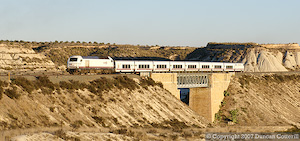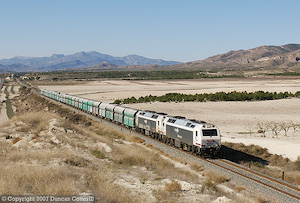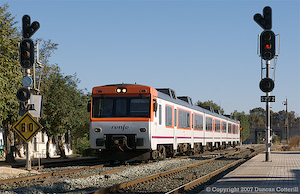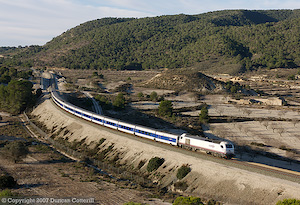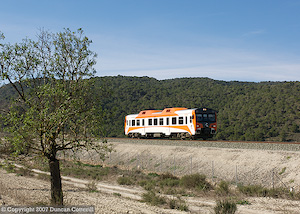Diesels on the Spanish Main (Line)
15 - 18 November 2007
Report by Duncan Cotterill
Introduction
Mainland Spain had been off my radar since the F. C. de Ponferrada-Villablino dieselised in 1981 but the appearance of an article on diesels around Murcia by Gary Corbett in Today’s Railways Europe 138 brought the country right back onto the agenda. The opportunity for a short trip presented itself in mid November 2007 so I set off for sunny Spain with Chris Wilkinson to see what RENFE had to offer photographically. We met up with Phil Wormald in Murcia and spent four days exploring the area by car.
The Line
The line we visited runs north from the coastal city of Cartagena to Albacete, on the electrified main line from Valencia and Alicante to Madrid. En route, it passes through Murcia, the provincial capital and the junction of lines south-west to Aguilas and north-east to Alicante.
Just outside Cartagena, a short branch comes in from Escombreras where the oil refinery and cement works are major sources of freight traffic. The next 30km or so are fairly straight and uninspiring as the line climbs gently away from the coast. North of Balsicas the gradient steepens as the line climbs over the 258m San Pedro Pass before turning westward, dropping into the Rio Segura valley and reaching the junction with the Alicante line at Los Ramos-Alquerias on the eastern edge of the Murcia conurbation. After running through Murcia, the line turns north again at Alcantarilla, junction of the Aguilas line, and follows the Rio Segura north, climbing through increasingly barren and mountainous country via Cieza and Calasparra to Hellin. From there the route north takes the line out of the mountains and across the plateau some 800m above sea level to meet the east-west electric line at Chinchilla, around 160km north of Murcia and 18km east of Albacete .
Passenger Trains
To somebody used to the one or two hourly regular interval patterns that have become the norm in many European countries, the passenger service on the Cartagena – Murcia – Albacete route could only be described as sparse. There are five pairs of trains from Madrid to Murcia on weekdays with four continuing to or from Cartagena. Saturdays are desperate with only two pairs of Madrid – Cartagena trains but Sundays are better with four pairs of trains. On mid November weekdays or Sundays that means four to six trains in daylight depending where you are. Saturday’s offer a meagre two or three daylight workings. These services are all formed of white Talgo coaches with “Altaria” branding and hauled by diesel locos of class 334 or 354. Only three of the original eight class 354s survive but we saw all of them in action during our visit with two different locos appearing on each of the three full days we had by the lineside.
There are also a handful of loco hauled services running from the Murcia area to Alicante and beyond. These are also formed of Talgo coaches, this time in blue and white livery and hauled by class 334 diesels. One service runs from Cartagena to Murcia and then north via Alicante and Barcelona to Montpellier. A second train starts at Lorca-Sutullena and runs via Murcia to Barcelona, while a third runs from Murcia to Barcelona.
See below for a full list of locos seen on passenger workings.
The infrequent regional services from Murcia to Cartagena and Alicante are worked by class 592.2 3-car DMUs or similar class 596 single cars. There are more frequent Alicante – Murcia and Murcia – Aguilas Cercanias services worked by 3-car class 592s although these don’t appear in the Hafas timetable for some reason.
Freight Trains
The industries of Escombreras generate most of the freight traffic in the area with regular block trains of clinker (unfinished cement) and liquefied natural gas heading towards the Madrid area. We also saw a block container train from the Alicante direction going north. Every freight we saw was hauled by a single class 333.3 diesel except for a southbound train of clinker hoppers that passed Calasparra around midday on Thursday and Friday and was worked by a pair of 333.3s. No freight workings were seen on Saturday or Sunday.
See below for a full list of locos seen on freight workings.
Photography
Photographing trains in south-eastern Spain was quite different to most places I've visited recently. The landscape had more in common with the American west than the green hills of central Europe and the trackside didn't suffer from the uncontrolled growth of vegetation found in many European countries. Another advantage was the weather, with hardly a cloud seen during the trip.
Please note that written permission is required to photograph railways in Spain.
Conclusions
I didn't expect to get many good photographs from this trip but was very pleasantly surprised. The good weather more than compensated for the sparse train service and there were plenty of excellent locations for photography.
The number of class 354 workings was also a pleasant surprise. I thought we'd be lucky to see one in traffic but the three survivors actually worked around 50% of the trains we saw on the route.
During the week there were enough trains to keep us occupied but with no freight and few passengers, Saturday was extremely quiet. This is definitely a line to do on weekdays.
With so few passenger trains, the only practical way to get around was by car. The lack of road signs in some towns, notably Cieza and Calasparra made this far more difficult than it should have been. We missed several shots due to not being able to find the right road out of town in spite of having good maps of the area. The traffic in Murcia itself was horrendous and finding our way through the maze of narrow streets to and from our hotel each day was quite an ordeal. It was just as well our hotel had a garage in the basement as parking in the city was next to impossible.
Overall, this was a very enjoyable trip and I would have no hesitation in returning to Spain in the future, particularly during the winter when the weather can be grim in much of Europe.
More photos from the trip can be seen on Phil's fotopic site:
http://www.loco-photos.net/index?/category/71-2007_11_spain (see pages 2 and 3)
Passenger Workings
SB/EB |
Thu 15/11 |
Fri 16/11 |
Sat 17/11 |
Sun 18/11 |
|
ARC1102 |
06:35 Murcia-Barcelona |
- |
- |
- |
n/a |
TLG460 |
08:35 Cartagena-Montpellier |
334 |
- |
334 010 |
334 012 |
ATR220 |
07:10 Madrid-Murcia |
- |
334 012 |
354 001 |
n/a |
ATR222 |
09:35 Madrid-Cartagena |
334 001 |
334 006 |
354 008 |
334 011 |
TLG264 |
13:00 Lorca-Barcelona |
- |
- |
334 007 |
- |
ARC1212 |
16:30 Murcia-Barcelona |
n/a |
n/a |
n/a |
- |
ATR228 |
12:40 Madrid-Cartagena |
354 006 |
354 008 |
n/a |
- |
ATR224 |
16:30 Madrid-Cartagena |
- |
- |
- |
- |
ATR226 |
19:05 Madrid-Cartagena |
- |
- |
n/a |
- |
NB/WB |
Thu 15/11 |
Fri 16/11 |
Sat 17/11 |
Sun 18/11 |
|
ATR221 |
05:30 Murcia-Madrid |
- |
- |
n/a |
n/a |
ATR223 |
08:55 Cartagena-Madrid |
354 001 |
354 001 |
354 001 |
334 007 |
ATR229 |
13:06 Murcia- |
334 009 |
334 012 |
n/a |
n/a |
ATR229 |
12:20 Cartagena-Madrid |
n/a |
n/a |
n/a |
354 006 |
ATR225 |
16:00 Cartagena-Madrid |
334 006 |
334 006 |
354 008 |
- |
TLG463 |
07:26 Montpellier-Cartagena |
- |
- |
- |
- |
ATR227 |
18:20 Cartagena-Madrid |
- |
- |
n/a |
- |
TLG165 |
15:00 Barcelona-Lorca |
- |
- |
- |
- |
ARC1171 |
16:30 Barcelona-Murcia |
- |
- |
- |
- |
Freight Workings
Thu 15/11 |
||||
333 353 |
SB |
Clinker Empties |
10:56 |
Riquelme-Sucina (Murcia – Cartagena) |
333 344 |
SB |
Gas Tanks |
11:57 |
Riquelme-Sucina |
| 333 3xx 333 3xx |
SB |
Clinker Empties |
13:02 |
Cieza |
Fri 16/11 |
||||
333 349 |
SB |
Gas Tanks |
09:32 |
Calasparra |
| 333 347 333 348 |
SB |
Clinker Empties |
11:37 |
Calasparra |
333 357 |
NB |
Clinker |
14:47 |
Calasparra |
333 340 |
NB |
Containers |
17:46 |
Cieza |
333 3xx |
NB |
Gas Tanks |
18:00 |
Cieza |
